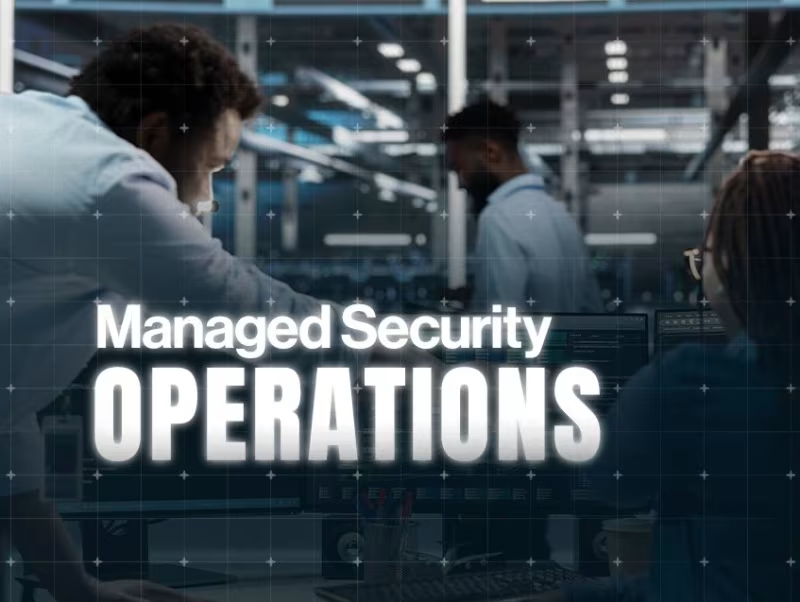Resource /
Effective Strategies to Managed Security Operations for Optimal Safety
Discover actionable strategies to strengthen security operations, integrate governance, adopt risk-based approaches, and leverage advanced technologies like SIEM, XDR, and SOAR for resilient business outcomes.
Published on Nov 18, 2025

Introduction
Managing security operations in today’s volatile cyber landscape is critical for organizational safety. With threats ranging from AI-driven phishing and ransomware to supply chain attacks, security teams face mounting challenges. Geopolitical tensions, complex systems, and the rapid pace of new technology make it increasingly challenging to manage risks, which is why robust information security management is indispensable.
This article aims to provide actionable strategies that are supported by the latest technologies and best practices. It seeks to empower decision-makers in their efforts to strengthen defenses, safeguard sensitive data, and achieve resilient business outcomes.
Building a Comprehensive Security Operations Framework
A. Establish Clear Governance and Roles
Define responsibilities for the Security Operations Center (SOC), incident response teams, and key stakeholders, including the Chief Information Security Officer (CISO). Using collaborative platforms to streamline workflows, enhance visibility, and ensure seamless coordination across security teams for faster event management and effective incident handling.
B. Develop and Regularly Update Security Policies
Strong security policies form the backbone of an effective information security management system. These policies should clearly define access controls, endpoint protection, incident response, and data handling standards. Regular reviews, guided by risk assessments, audit insights, and threat intelligence, ensure policies remain aligned with evolving threats and business priorities. This proactive approach strengthens resilience and supports compliance across the organization.
C. Adopt a Risk-Based Approach
Adopting a risk-based approach transforms security operations into a strategic function. Leaders should champion regular risk assessments to identify critical assets and prioritize resources toward the most significant threats. Leveraging frameworks like NIST RMF and ISO 31000 ensures decisions are structured, defensible, and aligned with business objectives. This approach enables executives to allocate budgets effectively, invest in the right technologies, and maintain resilience, protecting sensitive data while supporting long-term business continuity.
By driving governance, enforcing adaptive policies, and prioritizing risk-based decisions, leaders create a security framework that empowers teams, improves visibility, and enables proactive incident response, ultimately protecting critical systems, data, and customer trust.
Leveraging Advanced Technologies for Security Operations
Modern security operations centers (SOC) leverage advanced technologies not just for technical efficiency but as enablers of strategic leadership decisions. Tools like SIEM, XDR, and SOAR provide real-time visibility and actionable insights, allowing executives to prioritize risks, allocate resources effectively, and align security investments with business objectives.
By integrating these technologies into governance and risk frameworks, leaders transform security operations from a reactive function into a proactive driver of resilience and trust.
A. Security Information and Event Management (SIEM) and Extended Detection and Response (XDR)
Security Information and Event Management (SIEM) and Extended Detection and Response (XDR) platforms play a central role in aggregating log data, correlating security events, and enabling real-time visibility into cyber threats. When integrated with AI and machine learning, these systems improve alert precision, reduce false positives, and accelerate the detection of complex security incidents across endpoints, networks, and cloud environments.
B. Automation and Orchestration (SOAR)
Security Orchestration, Automation, and Response (SOAR) tools automate repetitive tasks such as incident triage, ticketing, and response workflows. This not only shortens response times but also optimizes the workload of security analysts, allowing them to focus on high-priority security threats and strategic risk management strategies.
C. Threat Intelligence and Analytics
Incorporating threat intelligence feeds, both internal and external, enables security teams to proactively defend against emerging attacks. Combined with entity behavior analytics and anomaly detection, these insights help identify unknown threats and suspicious patterns that traditional tools may miss.
D. Cloud-Native and Hybrid Security Monitoring
With the rise of cloud security, organizations must monitor across cloud-native, on-premises, and hybrid infrastructures. Distributed environments pose visibility and integration challenges, but solutions like Microsoft Defender, unified dashboards, and edge-based processing help maintain consistent security controls and compliance across platforms.
Advanced security technologies do more than improve operational efficiency, they enable leadership to make informed, strategic decisions. This synergy between technology and leadership ensures resilient operations, protects sensitive data, and reinforces trust across the organization.
Enhancing Human Factors and Workforce Capabilities
Continuous training ensures security professionals and security analysts remain prepared for evolving cybersecurity threats. Leveraging cyber ranges and simulation exercises provides realistic practice for incident response plans, threat detection, and event management, improving readiness within the security operations center (SOC).
Effective security operations hinge on clear communication between security teams, IT, and business units. Defined escalation paths and reporting mechanisms ensure rapid, coordinated responses during incidents. Employee education on policies and best practices builds a strong human firewall, while awareness programs reduce risks from phishing and insider threats. Leadership endorsement and role-based training embed security into daily workflows, minimizing vulnerabilities and reinforcing compliance.
Measuring Effectiveness and Continuous Improvement
To manage security operations effectively, organizations must define clear KPIs and metrics that reflect the performance of their SOC. Common indicators include Mean Time to Detect (MTTD), Mean Time to Respond (MTTR), incident volume, severity levels, false positive rates, and security training completion.
Regular audits, tabletop exercises, and incident postmortems validate these metrics and uncover gaps in security controls, event management, and information security management systems. These activities also support regulatory compliance and reinforce security baselines.
Emerging Trends in Managed Security Operations
The future of managed security operations is increasingly intelligence-driven, automated, and collaborative. AI-powered SOC are leveraging predictive analytics and autonomous response to anticipate cybersecurity threats and execute remediation playbooks without human intervention, reducing response times and improving the organization’s security posture.
Integration of Zero Trust architecture within information security management systems strengthens identity verification and access management, minimizing attack surfaces across cloud security and hybrid infrastructures. AI enhances Zero Trust by dynamically adapting security policies based on real-time threat detection and compliance data.
Finally, federated defense initiatives and industry-wide threat intelligence sharing improve collective resilience, enabling security teams to detect and respond to security incidents faster. Emerging techniques like behavioral biometrics and identity threat detection add contextual intelligence, monitoring user behavior for anomalies that signal insider risks or compromised credentials.
Conclusion
Executives play a pivotal role in shaping a security-first culture by championing governance, endorsing adaptive policies, and prioritizing risk-based strategies. Invest in a security framework that empowers teams, strengthens trust, and positions your organization to thrive amid evolving threats. Collaborate with TechDemocracy, a cybersecurity service provider to build a security operations strategy that aligns with your business goals and delivers measurable results.
Recommended articles


How Managed SOCs Improve Cybersecurity
Take Your Identity Strategy
to the Next Level
Strengthen your organization's digital identity for a secure and worry-free tomorrow. Kickstart the journey with a complimentary consultation to explore personalized solutions.